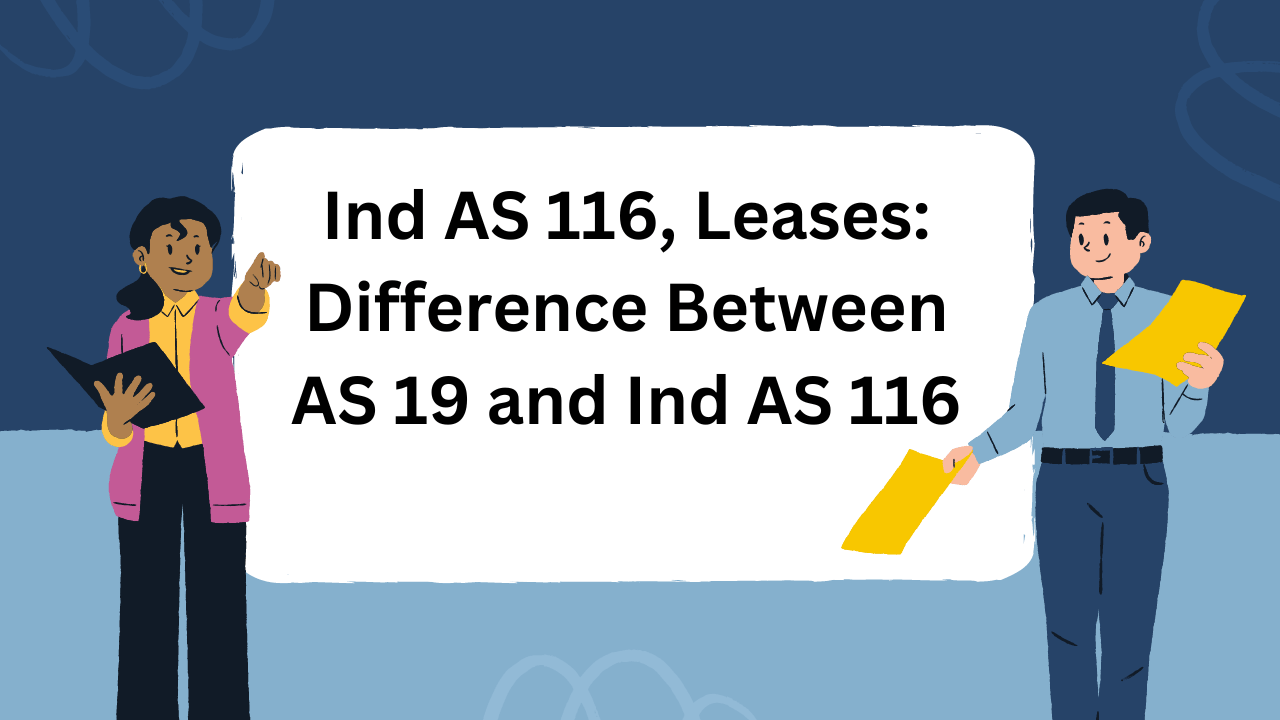Ind AS 116 sets out the principles for the recognition, measurement, presentation, and disclosure of leases and faithful representation of the transactions by lessees and lessors. This information gives a basis for users of financial statements to assess the effect that leases have on the financial position, financial performance, and cash flows of an entity.
Quick Links
Scope
The standard applies to all leases, including leases of right-of-use assets in a sublease, except for:
- (a) Leases to explore for or use minerals, oil, natural gas, and similar non-regenerative resources;
- (b) Leases of biological assets within the scope of Ind AS 41, Agriculture held by a lessee;
- (c) Service concession arrangements within the scope of Appendix D, Service Concession Arrangements of Ind AS 115, Revenue from Contracts with Customer;
- (d) Licences of intellectual property granted by a lessor within the scope of Ind AS 115, Revenue from Contracts with Customers; and
- (e) Rights held by a lessee under licensing agreements within the scope of Ind AS 38, Intangible Assets for such items as motion picture films, video recordings, plays, manuscripts, patents, and copyrights.
A lessee may, but is not required to, apply Ind AS 116 to leases of intangible assets other than those described in point (e) above.
This Standard specifies the accounting for an individual lease. However, as a practical expedient, an entity may apply this Standard to a portfolio of leases with similar characteristics if the entity reasonably expects that the effects on the financial statements would not differ materially. Must Check Limitations of Accounting.
Queries
| Question | Answer |
| After the introduction of IND AS 116 operating leases also should be treated as finance leases In this case assets are recognized as Right of use assets in the Balance sheet and corresponding liability is to be created as Lease obligation Interest is to be charged in the Statement of Profit Loss In this case interest expenditure allowable under Income Tax act and lease can take depreciation benefit under IT | At present CBDT has not given any specific guideline on tax application as per Ind AS 116. In an operating lease, ownership of property lies with the lessor. Lessee is allowed to use the property for its business or profession against a periodical rent payment. In IND AS 116, lease rent is reamed as lease interest. Under section 37 of the IT Act, expenses not categorically specified in sections 30 to 36, can be allowed as business expenditures, subject to conditions provided u/s 37. Lease rent/ Hirer charges are allowed u/s 37 as a deduction and since in IND AS 116 lease rent is renamed as interest on lease and the other hand interest on lease is income for the lessor. So considering the accounting treatment of income and expenditure of interest on the lease in the account of the lessee and lessor, it may be allowed as a deduction u/s 37. To claim depreciation u/s 32, two conditions must be satisfied. One is the assessee must be the owner of that property and second it is used for business or profession. Since in an operating lease agreement, ownership is not transferred to the lessee, it is lying to the lessor. So in this case depreciation is not allowable u/s 32 in the hands of the lessee. |
Leases in the financial statements of lessees
Operating Lease
Lease payments under an operating lease shall be recognized as an expense on a straight-line basis over the lease term unless either another systematic basis is more representative of the time pattern of the user’s benefit or the payments to the lessor are structured to increase in line with expected general inflation to compensate for the lessor’s expected inflationary cost increases.
Finance leases
At the commencement of the lease term, lessees shall recognize finance leases as assets and liabilities in their balance sheets at amounts equal to the fair value of the leased property or, if lower, the present value of the minimum lease payments, each determined at the inception of the lease. The discount rate to be used in calculating the present value of the minimum lease payments is the interest rate implicit in the lease, if this is practicable to determine; if not, the lessee’s incremental borrowing rate shall be used. Any initial direct costs of the lessee are added to the amount recognized as an asset.
Minimum lease payments shall be apportioned between the finance charge and the reduction of the outstanding liability. The finance charge shall be allocated to each period during the lease term to produce a constant periodic rate of interest on the remaining balance of the liability. Contingent rents shall be charged as expenses in the periods in which they are incurred.
A finance lease gives rise to depreciation expense for depreciable assets as well as finance expense for each accounting period. The depreciation policy for depreciable leased assets shall be consistent with that for depreciable assets that are owned, and the depreciation recognized shall be calculated following Ind AS 16, Property, Plant, and Equipment, and Ind AS 38, Intangible Assets. If there is no reasonable certainty that the lessee will obtain ownership by the end of the lease term, the asset shall be fully depreciated over the shorter of the lease term and its useful life.
Leases in the financial statements of lessors
Operating leases
Lessors shall present assets subject to operating leases in their balance sheet according to the nature of the asset. The depreciation policy for depreciable leased assets shall be consistent with the lessor’s normal depreciation policy for similar assets, and depreciation shall be calculated following Ind AS 16 and Ind AS 38. Lease income from operating leases (excluding amounts for services such as insurance and maintenance) shall be recognized in income on a straight-line basis over the lease term unless either
- another systematic basis is more representative of the time pattern in which use benefit derived from the leased asset is diminished, even if the payments to the lessors are not on that basis; or
- the payments to the lessor are structured to increase in line with expected general inflation to compensate for the lessor’s expected inflationary cost increases. If payments to the lessor vary according to factors other than inflation, then this condition is not
Finance leases
Lessors shall recognize assets held under a finance lease in their balance sheets and present them as receivable at an amount equal to the net investment in the lease. The recognition of finance income shall be based on a pattern reflecting a constant periodic rate of return on the lessor’s net investment in the finance lease.
Manufacturer or dealer lessors shall recognize selling profit or loss in the period, following the policy followed by the entity for outright sales. If artificially low rates of interest are quoted, selling profit shall be restricted to that which would apply if a market rate of interest were charged. Costs incurred by manufacturer or dealer lessors in connection with negotiating and arranging a lease shall be recognized as an expense when the selling profit is recognized.
Sale and leaseback transactions
A sale and leaseback transaction involves the sale of an asset and the leasing back of the same asset. The lease payment and the sale price are usually interdependent because they are negotiated as a package. The accounting treatment of a sale and leaseback transaction depends upon the type of lease involved.
Appendix C of IndAS 116 provides guidance (a) for determining whether the arrangement is, or contains, leases that should be accounted for following Ind AS 116; (b) when the assessment or a reassessment of whether an arrangement is, or contains, a lease should be made; and (c) if an arrangement is, or contains, a lease, how the payments for the lease should be separated from payments for any other elements in the arrangement. You may also like Accrued Liabilities.
Appendix A of Ind AS 116 guides the recognition of incentives in an operating lease in the financial statements of the lessor and lessee. The Appendix prescribes that the lessor shall recognize the aggregate cost of incentives as a reduction of rental income over the lease term, on a straight-line basis unless another systematic basis is representative of the time pattern over which the benefit of the leased asset is diminished. The lessee shall recognize the aggregate benefit of incentives as a reduction of rental expense over the lease term, on a straight-line basis unless another systematic basis is representative of the time pattern of the lessee’s benefit from the use of the leased asset.
Difference Between AS 19 and Ind AS 116
| AS 19 | Ind AS 116 |
| AS 19 does not apply to the lease of lands. | Though both the terms are used in some places in AS 19, these terms are not defined and distinguished. |
| The term “Residual Value” is defined in AS 19. | Ind AS 116 does not define “Residual Value”. |
| There are some differences in disclosure requirements of AS 19 and Ind AS 116. | |
| Ind AS 116 requires current/non-current classification of lease liabilities if such classification is made for other liabilities also. It also refers Ind AS 105 on “Non-current Assets Held for Sale and Discontinued Operations “. | Ind AS 116 makes a distinction between inception of lease and commencement of lease. |
| As per AS 19, such recognition is at the inception
of the lease. | As per Ind AS 116, the lessee shall recognize finance leases as assets and liabilities in the balance sheet at the commencement of the lease term |
| This aspect is not dealt with in AS 19. | Ind AS 116 guides accounting for:
|
| AS 19 does not contain such provisions | Separate Ind AS deals with measurement aspects of investment properties (Ind AS 40) and biological assets (Ind AS 41). Accordingly, if such assets are provided or held under a lease agreement, then the measurement principles, given in Ind AS 116 will not apply. |
| The existing standard does not contain such guidance | Ind AS 116 provides guidance on accounting for:
|
| AS 19 prohibits upward revision of unguaranteed residual value, during the term of the lease | Ind AS 116 permits upward revision of unguaranteed residual value, during the term of the lease |
| Ind AS 116 also specifies that in case of a sale and leaseback transaction (in case of finance lease), the excess of sale proceeds, over the carrying amount of the asset, is to be deferred and amortized by the seller(lessee), but it does not specify the method of amortization. | Ind AS 116 requires current/non-current classification of lease liabilities if such classification is made for other liabilities also. It also refers to Ind AS 105 on “Non-current Assets Held for Sale and Discontinued Operations “. |
| These matters are not addressed in the existing standard. | Ind AS 116 states that the initial direct costs, incurred by the lessor (in case of operating lease), shall be included in the carrying amount of leased asset and amortized as an expense, over the lease period. |
| AS 19 does not provide for the same. | Ind AS 116 states that in the case of an operating lease, if escalation of lease rentals is attributable to the expected general inflation to compensate the lessor for expected inflationary costs shall not be straight-lined. |
| AS 19 requires the initial direct costs, incurred by the lessor(in case of operating lease), to be either charged off, at the time of incurrence or to be amortised over the lease period | AS 19 requires the initial direct costs, incurred by the lessor(in case of operating lease), to be either charged off, at the time of incurrence or to be amortized over the lease period |







